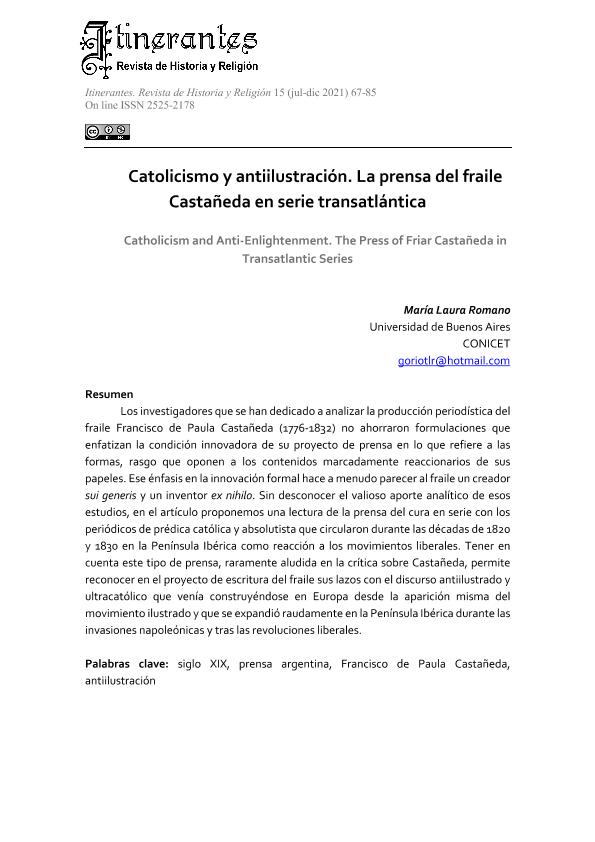Mostrar el registro sencillo del ítem
dc.contributor.author
Romano, María Laura

dc.date.available
2023-09-18T13:34:01Z
dc.date.issued
2021-12
dc.identifier.citation
Romano, María Laura; Catolicismo y antiilustración: La prensa del fraile Castañeda en serie transatlántica; Universidad del Norte Santo Tomás de Aquino. Facultad de Humanidades. Instituto de Investigaciones Históricas "Prof. Manuel García Soriano"; Itinerantes; 15; 12-2021; 67-85
dc.identifier.issn
2250-5377
dc.identifier.uri
http://hdl.handle.net/11336/211778
dc.description.abstract
Los investigadores que se han dedicado a analizar la producción periodística del fraile Francisco de Paula Castañeda (1776-1832) no ahorraron formulaciones que enfatizan la condición innovadora de su proyecto de prensa en lo que refiere a las formas, condición que tensionan con los contenidos marcadamente reaccionarios de sus papeles. Ese énfasis en la innovación formal hace a menudo parecer al fraile un creador sui generis y un inventor ex nihilo. Sin desconocer el valioso aporte analítico de esos estudios, en el artículo proponemos una lectura de la prensa del cura en serie con los periódicos de prédica católica y absolutista que circularon durante las décadas de 1820 y 1830 en la Península Ibérica como reacción a los movimientos liberales. Tener en cuenta este tipo de prensa, raramente aludida en la crítica sobre Castañeda, permite reconocer en el proyecto de escritura del fraile sus lazos con el discurso antiilustrado y ultracatólico que venía construyéndose en Europa desde la aparición misma del movimiento ilustrado y que se expandió raudamente en la Península Ibérica durante las invasiones napoleónicas y tras las revoluciones liberales.
dc.description.abstract
Researchers who have devoted themselves to analyze the journalistic production of the friar Francisco de Paula Castañeda (1776-1832) did not spare wordings that emphasize the innovative condition of his press project in terms of forms, a condition that stresses with the markedly reactionary contents of his work. This emphasis on formal innovation often makes the friar seem like a sui generis creator and an ex nihilo inventor. Without ignoring the valuable analytical contribution of these studies, in this article we propose a reading of the priest's press in series with the Catholic and absolutist preaching newspapers that circulated in the 1820s and 1830s on the Iberian Peninsula as a reaction to the liberal movements. Taking into account this type of press, rarely alluded to in the criticism of Castañeda, allows us to recognize in the friar's writing project his ties with the anti-enlightened and ultra-Catholic discourse that had been being built in Europe since the very appearance of the Enlightenment movement and that expanded quickly in the Iberian Peninsula during the Napoleonic invasions and after the liberal revolutions.
dc.format
application/pdf
dc.language.iso
spa
dc.publisher
Universidad del Norte Santo Tomás de Aquino. Facultad de Humanidades. Instituto de Investigaciones Históricas "Prof. Manuel García Soriano"
dc.rights
info:eu-repo/semantics/openAccess
dc.rights.uri
https://creativecommons.org/licenses/by-nc/2.5/ar/
dc.subject
SIGLO XIX
dc.subject
PRENSA ARGENTINA
dc.subject
FRANCISCO DE PAULA CASTAÑEDA
dc.subject
ANTIILUSTRACIÓN
dc.subject.classification
Otras Lengua y Literatura

dc.subject.classification
Lengua y Literatura

dc.subject.classification
HUMANIDADES

dc.title
Catolicismo y antiilustración: La prensa del fraile Castañeda en serie transatlántica
dc.title
Catholicism and Anti-Enlightenment. The Press of Friar Castañeda in Transatlantic Series
dc.type
info:eu-repo/semantics/article
dc.type
info:ar-repo/semantics/artículo
dc.type
info:eu-repo/semantics/publishedVersion
dc.date.updated
2023-09-14T17:33:38Z
dc.identifier.eissn
2525-2178
dc.journal.number
15
dc.journal.pagination
67-85
dc.journal.pais
Argentina

dc.journal.ciudad
San Miguel de Tucumán
dc.description.fil
Fil: Romano, María Laura. Consejo Nacional de Investigaciones Científicas y Técnicas. Centro Científico Tecnológico Conicet - La Plata. Instituto de Investigaciones en Humanidades y Ciencias Sociales. Universidad Nacional de La Plata. Facultad de Humanidades y Ciencias de la Educación. Instituto de Investigaciones en Humanidades y Ciencias Sociales; Argentina
dc.journal.title
Itinerantes
dc.relation.alternativeid
info:eu-repo/semantics/altIdentifier/url/https://revistas.unsta.edu.ar/index.php/Itinerantes/article/view/482
dc.relation.alternativeid
info:eu-repo/semantics/altIdentifier/doi/https://doi.org/10.53439/revitin.2021.2.05
Archivos asociados
